
Department of Energy Ignoring Cleanup Plan That Saves $18B
August 29, 2022
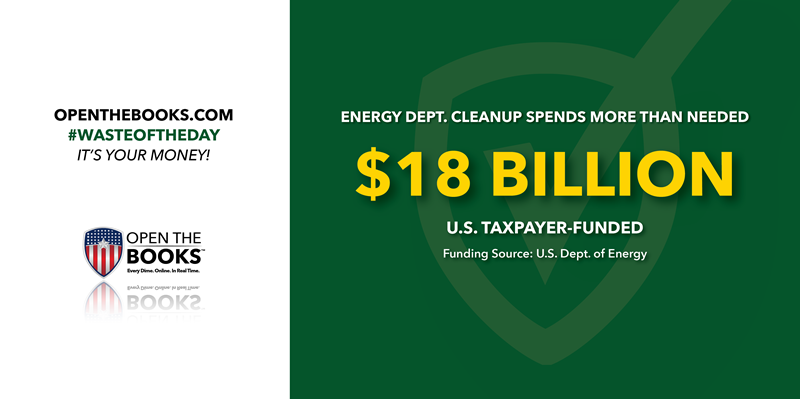
A massive Department of Energy environment cleanup in Washington State that’s years behind schedule and billions of dollars over budget, could save up to $18 billion if it followed recommendations by the U.S. Government Accountability Office, something it has yet to do.
The nuclear waste cleanup at the Hanford Site in Washington is “one of the largest and most expensive environmental cleanup projects in the world,” a July 2022 GAO report stated.
Weapons-grade nuclear materials were produced for decades at the 586-square-mile campus until the late 1980s, when the DOE began cleanup of hazardous and radioactive waste.
The waste created as a byproduct of producing nuclear weapons includes 54 million gallons stored in 177 large underground waste storage tanks. Federal and state environmental laws require that the waste be treated before it’s disposed.
The current cleanup plan calls for a Waste Treatment and Immobilization Plant, which has been under construction since 2000, and includes creating several waste treatment facilities, including a facility to vitrify — or convert — all of Hanford’s high-level waste and a separate facility to vitrify about 60 percent of its low activity waste. The plan is also looking at creating a second vitrification facility for the rest of the low activity waste.
In May 2017, GAO reported that “experts believed that much of Hanford’s supplemental [low activity waste] could be safely grouted — that is, immobilized in a concrete mixture.”
The office stated in January 2021 “that DOE could save up to $18 billion by filling the closed tanks with grout and leaving them in place, rather than exhuming them for disposal elsewhere, as the state of Washington may require.”
Who wouldn’t want to save $18 billion? The GAO suggested the DOE seeks stakeholders’ buy-in to the decision-making process.
Unfortunately, that wasn’t the case and GAO reported that “DOE faces challenges in engaging stakeholders, including local, regional, and national entities, as well as tribal governments.”
CA’s College Savings Plan Could Cost Almost $2B in First Year
August 30, 2022
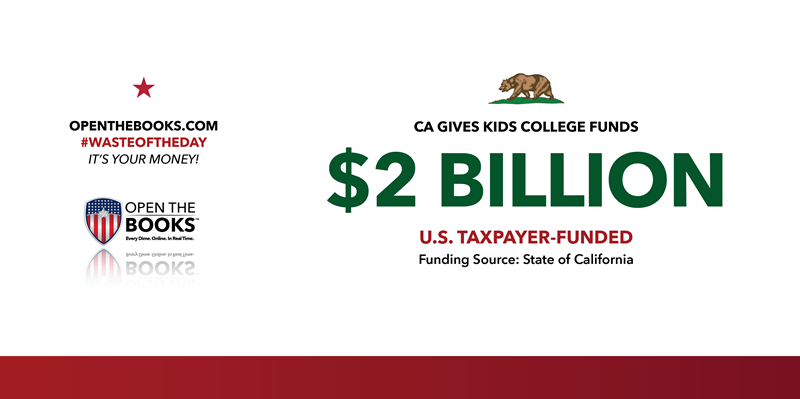
The State of California’s new taxpayer-funded scholarship program to help pay for kids’ college tuition, CalKIDS, could cost taxpayers as much as $1.9 billion the first year.
The program is being rolled out to help children start saving for college from the day they’re born, the Los Angeles Times reported.
With tuition in the University of California system upwards of $13,000 a year, and fees, housing for on-campus students, meals and other costs adding another $25,000, students can pay almost $40,000 for a state school.
The state has decided not to lower tuition costs but to subsidize them by giving newborns up to $100 each for college savings accounts, and up to $1,500 each for older, low-income kids
In 2020, 420,259 babies were born in California, according to March of Dimes. At $100 each, that’s $42 million each year to California’s babies, if all parents opt in to the program. There is no citizenship requirement, the LA Times reported.
In the 2020-21 school year, the state had more than 6 million K-12 students, according to the California Department of Education. Six out of ten students are low-income. That’s 3.6 million students who are eligible for tuition scholarships from this taxpayer funded system
Not many will get the entire $1,500 — low-income children entering first grade in public schools will automatically receive $500. Kids living with foster parents will receive another $500; homeless kids will get an additional $500.
Public-school students who were in grades 1 through 12 last year will be automatically enrolled, with the same grants available, the LA Times reported.
The Sacramento Bee reported that the program dedicates $1.9 billion to low-income students in grades 1-12 and newborns who were born on or after July 1.
State officials say the “free” money is meant to encourage more kids to continue their studies after high school. That’s a noble goal but spending taxpayer money to do so, all while keeping tuition rates high, isn’t the way to do it.
NY School District Inflated Budget, Raised Taxes
August 31, 2022
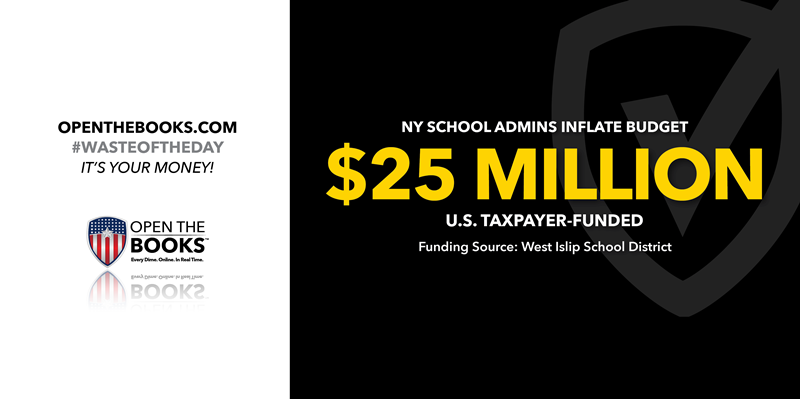
School officials in a New York school district overestimated how much it costs to run the schools and even raised taxes, all to be caught with a $25 million surplus, an audit by the New York State Comptroller’s Office found.
Over four years, the West Islip Union Free School District on Long Island overestimated expenses by almost $25 million and hid its surplus funds, the audit found, Newsday reported.
Each year, district officials overestimated costs by about 5 percent on average, with surplus funds ranging from 7 percent to almost 8 percent of the next year's budget, as opposed to the legal maximum of 4 percent.
School districts are supposed to draw down excess surplus funds, not raise taxes and continue to add to it.
The auditors in state Comptroller Thomas P. DiNapoli’s office recommended the district "adopt realistic budgets" and use reserves to benefit district residents.
The overestimated budgets "resulted in real property tax levies that are higher than necessary,” the audit said, noting that the district raised the tax levy by about $6.2 million from school year 2017-2018 through 2020-2021, Newsday reported.
Seeing its excess funds, the district made $17.9 million worth of unbudgeted transfers to its reserve funds, the audit found.
The “extra money” came after the district overestimated costs for tuition, services for students with disabilities, health insurance and employee retirement system contributions, the report said. That lead to collecting more tax money than needed to pay for those things, and an inflated surplus.
The 2021-2022 budget was $127.5 million, and as of June 30, 2021, the district had $18.7 million in operating surplus and $30.2 million in total reserves, Newsday reported.
School district officials need to be reminded that it’s not their money to play with, it’s the taxpayers' money.
Throwback Thursday: NASA Pays Big for Writings from Junior Author
September 1, 2022
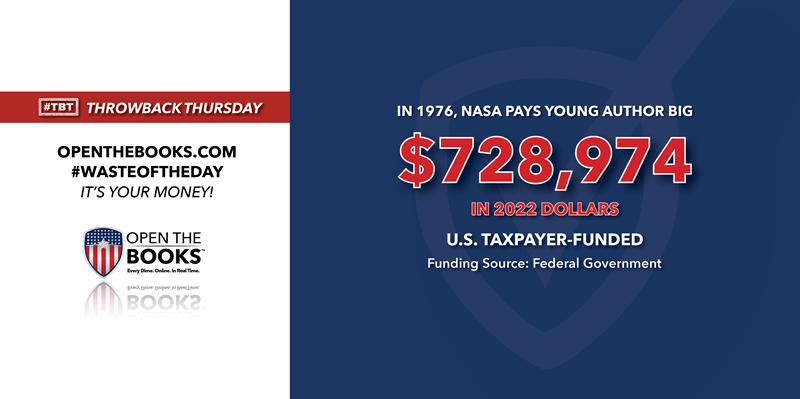
Throwback Thursday!
In 1976, National Aeronautics and Space Administration paid $140,000 — $728,974 in 2022 dollars — to a contractor to write a 6,000-word article and a book length history of the Viking Mars Landing project.
The wasteful spending earned NASA a Golden Fleece of the Month award from Sen. William Proxmire, a Democrat from Wisconsin.
The author was paid $24,000 for the 6,000-word article on the landing and initial operations of the two Viking spacecraft, then another $116,000 for a longer version.
“If a major publishing firm had given an author $24,000 for a 6,000-word short story with the promise of another $116,000 for a book, pending further negotiations, the lucky recipient would be an overnight celebrity,” Proxmire wrote in giving the award.
The NASA deal was “proffered on a silver platter,” he said, to a young man who didn’t have major published works under his belt.
Proxmire compared the writing deal to Samuel Eliot Morison’s “History of the United States Naval Operations in World War II,” published in 15 volumes between 1947 and 1962 and for which Morison was paid $15,000 per volume — between $147,156 and $199,288 in 2022 dollars, depending on which volume.
Morison was a historian with a PhD from Harvard and university history teacher, who won Pulitzer Prizes for two biographies on Christopher Columbus and John Paul Jones and was awarded the Presidential Medal of Freedom, among other prestigious honorarium.
“The NASA-picked author is receiving more for writing a 6,000-word article than Commander Morison got for writing an entire volume,” Proxmire said. “In fact, if the Commander had received $4 a word, as the NASA writer is, he would have been getting $300,000 or $400,000 per book.”
While the agreed-upon amount is far too high in Proxmire’s opinion, he said he couldn't blame the author.
“This is a far better deal than any but the most renowned author would get from a major publishing firm.”
He criticized NASA for not going through its normal procedure of relying on current historical literature and recommendations from its Historical Advisory Committee to select potential contractors rather than give the contract to a writer “whose experience consists largely of magazine articles plus an as yet unpublished book commissioned by NASA itself.”
Education Dept. Student Loan Projections Off By $311B
September 2, 2022
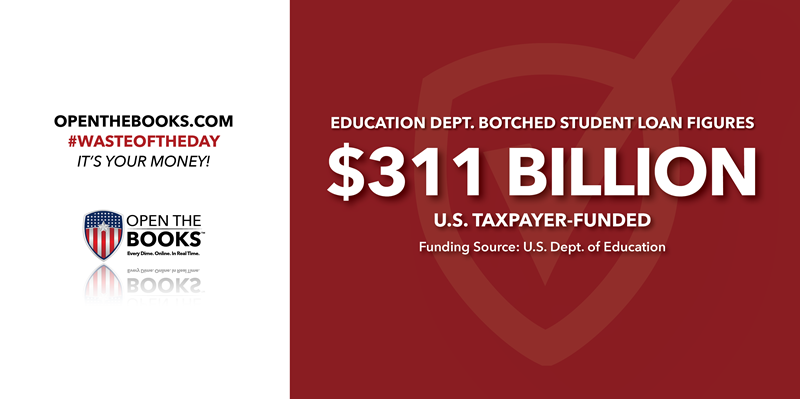
Bad assumptions on the part of the Department of Education led to federal student loans costing the government $197 billion since 1997 — instead of making $114 billion.
That’s according to a new report from the U.S. Government Accountability Office, which found that the $311 billion difference was due to “faulty assumptions.”
Federal student loans were “originally estimated to generate $6 in income per every $100 disbursed” but they’re actually “expected to cost the government almost $9 for every $100 disbursed.”
That’s quite a miscalculation.
The GAO found by looking through the Department of Education’s budgets over the years that about 61 percent of the bad accounting was due to these faulty assumptions, like incorrect estimates on the economic standing of borrowers, underestimating the likelihood of borrower default, and underestimating the percentage of borrowers who would enter income-driven repayment plans.
The Direct Student loan program, which is the largest federal student loan program, accounts for about $1.4 trillion of the $1.7 trillion in outstanding student loans, The Daily Signal reported.
About half of all loans issued in that program are being repaid through IDR plans, which cap monthly loan payments based on income.
The Congressional Budget Office reported in February 2020, “borrowers who enroll in IDR plans tend to borrow more and earn less than borrowers in fixed-payment plans.”
That means the student loan program is not only making less money than estimated, but also losing money.
The GAO found the other 39 percent of the miscalculation is due to “programmatic changes such as ongoing repayment pauses, participation in Public Service Loan Forgiveness, interest waivers, and new income-driven repayment plans,” the Signal reported.
And this isn’t about to be corrected anytime soon. The DOE will continue to use these inaccurate accounting metrics for the next three years, making the budget incorrect until at least 2026.
And none of the bad accounting includes the recent announcement from President Joe Biden that forgives $10,000 in students loans per person, costing an estimated $300 billion.
The #WasteOfTheDay is presented by the forensic auditors at OpenTheBooks.com.